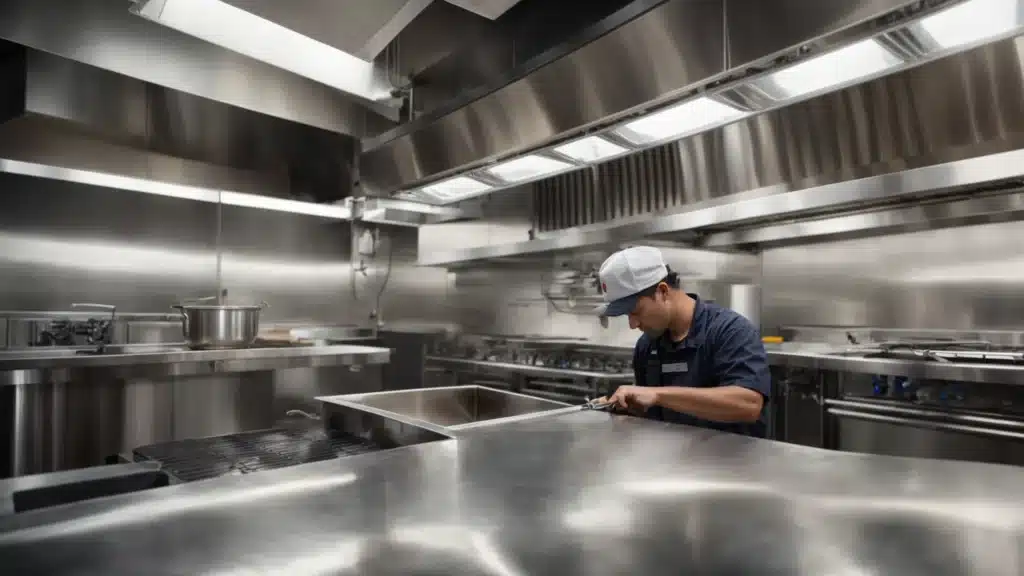Measures to Prevent Quick Buildup in Kitchen Exhaust System
Keeping Your Kitchen Exhaust Clean: Best Practices
Maintaining a sparkling clean kitchen exhaust not only ensures your restaurant operates within health standards but also prolongs the lifespan of your equipment and preserves the air quality in your kitchen.
Initiate this essential task with a comprehensive examination of your kitchen exhaust to identify any potential grease buildup or blockages.
Along the journey of keeping your kitchen safe and efficient, discover a blend of do-it-yourself cleaning methods and the invaluable assistance of professional services tailored to meet the unique demands of your commercial kitchen.
Dive into the array of preventative steps that can be taken to minimize future grime accumulation, all while grasping the serious implications that a neglected exhaust system can herald.
Keep reading to uncover the secrets to an impeccably maintained kitchen exhaust system, ensuring a safer, cleaner working environment for everyone.
Key Takeaways
- Regular Inspections and Maintenance of Kitchen Exhaust Systems Are Essential for Safety and Efficiency
- Signs of Grease buildup-Up, Such as Sticky Residue, Unusual Odors, and Reduced Airflow, Indicate the Need for Professional Cleaning
- Cleaning and Maintaining Hood Filters and Components extends the Life and Functionality of the Exhaust System
- Professional Cleaning Services Ensure Thorough Removal of Grease and Adherence to Safety Standards
- Maintaining a Detailed Maintenance Log Is Crucial for Compliance and Identifying Recurring Issues
Starting With a Kitchen Exhaust Inspection Routine
Maintaining a pristine kitchen exhaust system requires a proactive approach, starting with a meticulous inspection routine.
Restaurant owners and commercial establishments need to recognize the early indicators of grease accumulation within their exhaust systems, as this not only ensures operational efficiency but also upholds stringent Ontario Hood Cleaning safety standards.
Establishing a schedule for regular professional inspections is a cornerstone practice in preemptively addressing potential hazards, thereby safeguarding the well-being of both employees and customers alike.
This initial step lays the groundwork for understanding the importance of vigilance in kitchen exhaust maintenance and sets the stage for exploring the nuances of identifying signs of grease buildup and scheduling subsequent professional evaluations. Visit Our Blog for more information.
Identifying Signs of Grease Buildup in Your System
One unmistakable indicator of grease buildup in a kitchen exhaust system is the presence of an oily residue on surfaces near the exhaust hoods and vents. Such accumulation often manifests as a sticky film that can cling to walls, ceilings, and the kitchen equipment itself, hinting at the system’s inefficiency in capturing and removing grease particles during cooking processes.
Another telltale sign to look out for is an unusual odor emanating from the exhaust system. This odor is a result of grease and food particles that have been heated and re-heated, leading to decomposition and the emission of unpleasant smells. Ignoring this warning sign can not only affect the ambiance of your establishment but can also signal a significant risk of fire.
Reduced airflow from the vents is a critical symptom of grease buildup that requires immediate attention. When exhaust fans and hoods fail to expel smoke and heat at their designed capacity, it’s a clear indication that the filters and ducts are clogged with grease. This inefficiency can drastically affect kitchen temperature control and air quality, impacting both staff comfort and food safety standards.
Scheduling Regular Professional Inspections
Aligning with Ontario Hood Cleaning for routine inspections is a strategic move for any commercial establishment aiming to keep its kitchen exhaust system in top condition. These scheduled visits allow specialists to thoroughly examine the system, identifying small issues before they escalate into larger, potentially hazardous problems.
During these inspections, professionals from Ontario Hood Cleaning employ advanced techniques and tools to assess the extent of grease accumulation and check for any signs of wear or damage within the exhaust setup. This proactive approach ensures that all components, from hoods to filters and ducts, function efficiently, minimizing the risk of fire and enhancing the overall safety of the kitchen environment.
Setting up a regular appointment schedule with Ontario Hood Cleaning is not just about compliance; it’s an investment in the longevity of your kitchen’s air quality and safety. Establishments in Toronto and surrounding Areas Served by Ontario Hood Cleaning can rest assured that their kitchen exhaust systems are maintained to the highest standards, preserving the well-being of their staff and patrons.
Now that we’ve covered the essentials of setting up a kitchen exhaust inspection routine, let’s shift gears. Prepare to roll up your sleeves as we dive into DIY cleaning tips for your kitchen hood and filters!
DIY Cleaning Tips for Your Kitchen Hood and Filters
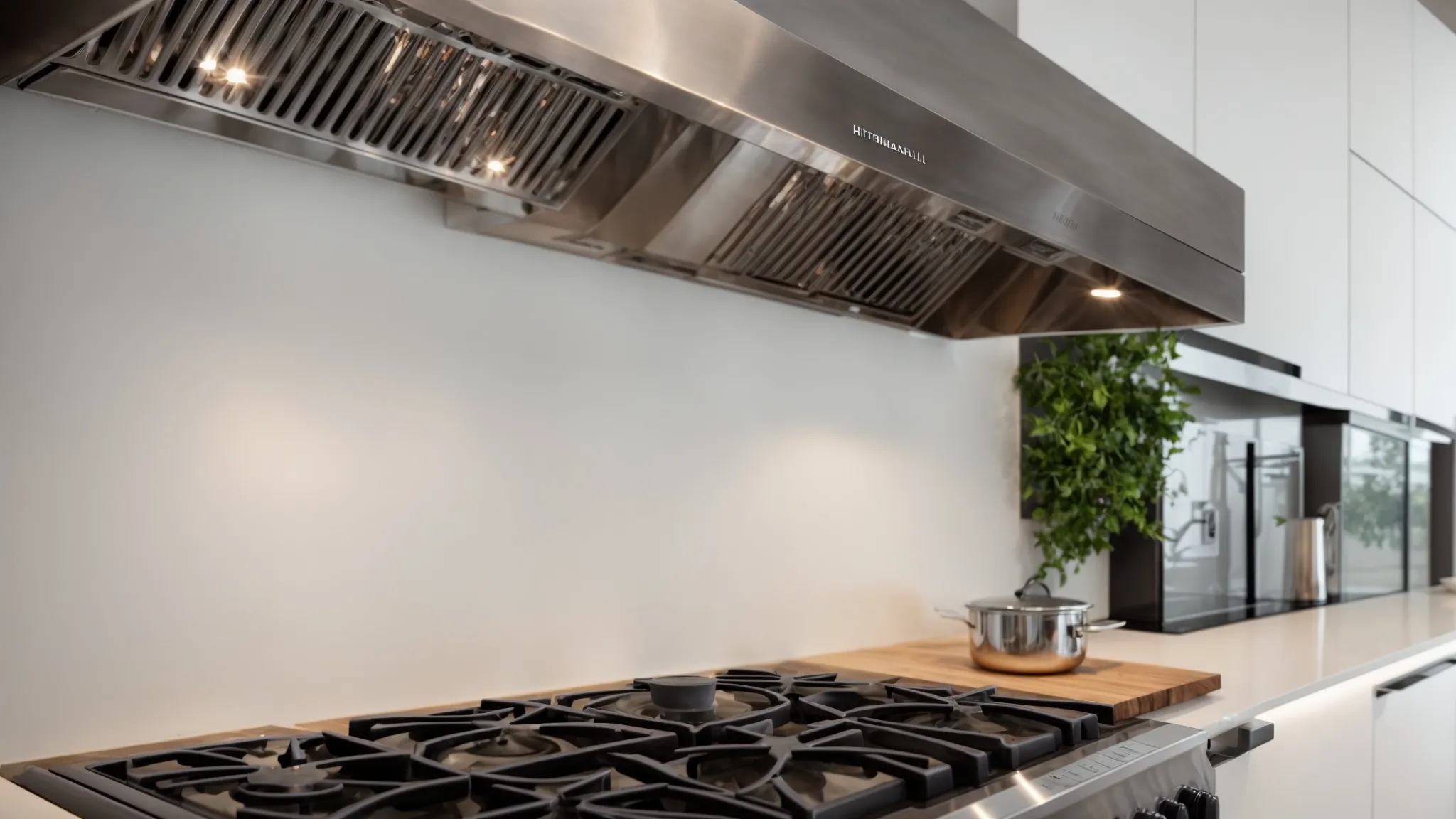
Maintaining a clean and efficient kitchen exhaust system extends beyond professional inspections and interventions.
Restaurant owners and kitchen staff can undertake some of the maintenance tasks, ensuring the longevity and effectiveness of their equipment.
Key among these tasks are the dismantling of hood components for a thorough cleanse and the careful selection of cleaning agents and tools suitable for the job.
This section delves into the actionable steps and considerations for conducting a deep cleaning of your kitchen hood and filters, emphasizing the importance of using appropriate substances and utensils to avoid damage while achieving optimal cleanliness.
Dismantling Components for a Deep Clean at Home
Embarking on a deep clean of your kitchen hood and filters begins with the careful dismantling of each component. This process requires patience and attention to detail, as removing these parts improperly could lead to damage or affect the system’s performance. Equip yourself with the right tools and a clear understanding of the manufacturer’s guidelines to ensure a smooth disassembly.
Once the components are dismantled, it’s critical to inspect each piece for signs of wear and tear or any damage that might have gone unnoticed during regular operation. This step is not just about cleaning; it’s an opportunity to assess the overall health of your exhaust system. Identifying issues early can save time and resources, preventing minor problems from escalating into major ones.
Cleaning the individual parts of the kitchen hood and filters involves using appropriate cleaning solutions that are effective against grease but gentle on the materials. It’s important to select cleaning agents that won’t corrode or damage the exhaust components. A meticulous approach to washing, rinsing, and drying each part will not only ensure a thorough cleaning but also extend the lifespan of your kitchen exhaust system.
Choosing the Right Cleaning Agents and Tools
Choosing the correct cleaning agents and tools is paramount when aiming to maintain a kitchen exhaust system’s efficiency and safety. The selection of detergents should focus on products specifically designed to cut through grease while being safe for use on metal surfaces. These specialized cleaners help ensure that grease is effectively removed without causing corrosion to the hood and filters.
For scrubbing away the grime, employing non-abrasive tools is critical to avoid scratching or damaging the surfaces of the hood and filters. Soft-bristled brushes and microfiber cloths are ideal, as they are tough on grease but gentle on the equipment. These tools, when used properly, facilitate a deep clean without compromising the integrity of the kitchen exhaust parts.
The use of a high-pressure washer can significantly enhance the cleaning process, particularly for hard-to-reach areas within the ductwork. However, it’s imperative to use this equipment cautiously to prevent water from damaging electrical components or causing unanticipated leaks. A balanced approach that combines suitable cleaners, gentle tools, and careful techniques guarantees a comprehensive cleaning while extending the lifespan of the exhaust system.
Transforming your kitchen’s cleanliness takes more than just elbow grease and home remedies. It’s time to step up your game with professional exhaust maintenance services!
Utilizing Professional Services for Exhaust Maintenance
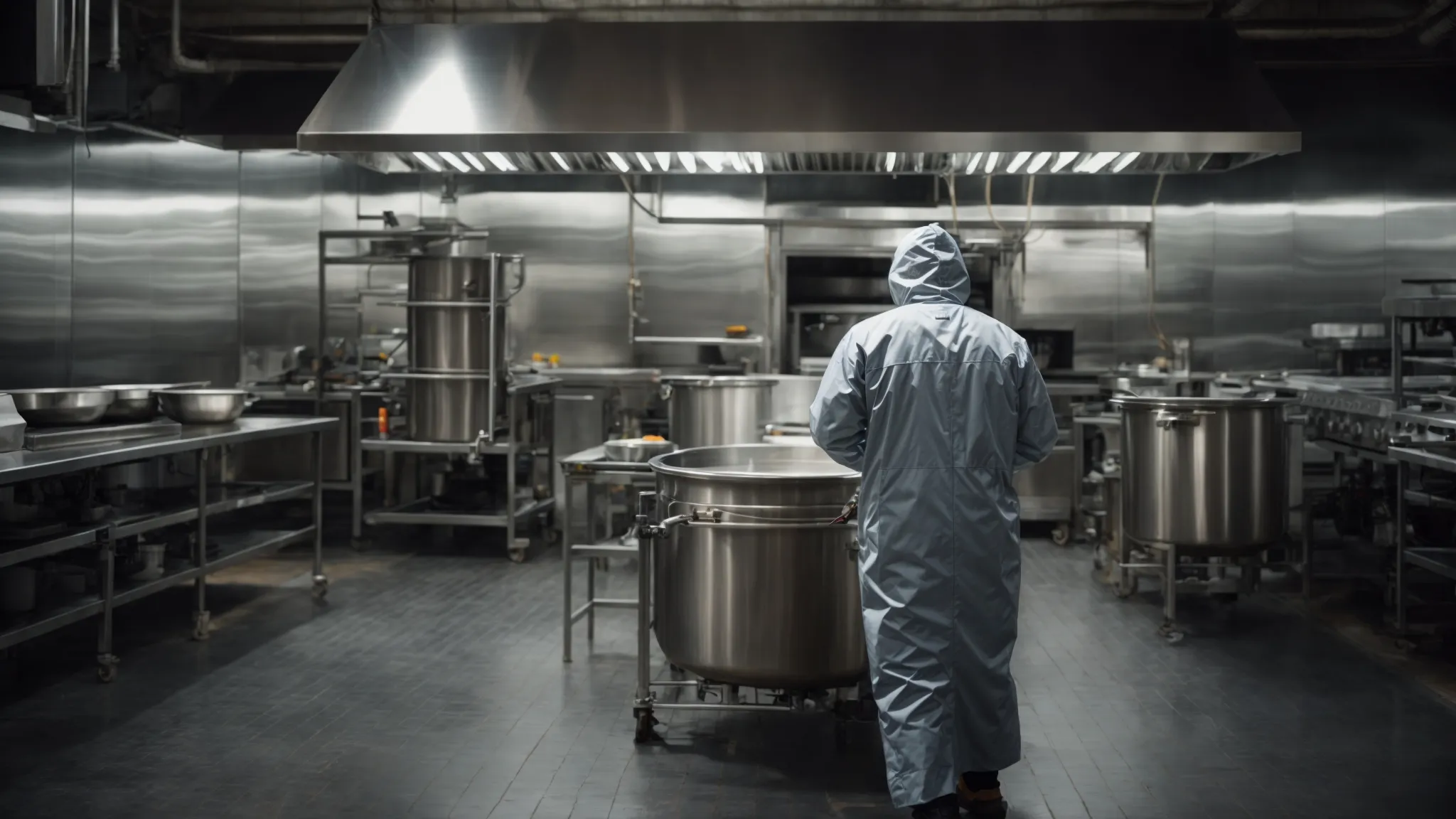
Ensuring the cleanliness and functionality of a kitchen exhaust system goes beyond routine checks and minor clean-ups; there are times when the expertise of professionals becomes indispensable.
Deciding when to engage the services of experts for a comprehensive cleaning can be a pivotal step in maintaining a safe and efficient kitchen environment.
When opting for professional exhaust maintenance, restaurant owners and commercial kitchen operators should know what to expect, from the initial inspection to the final assessment.
These steps are essential for not only adhering to health and safety regulations but also for extending the life span and functionality of the exhaust system.
This section explores the critical points of identifying the right time for professional intervention and the comprehensive process involved in a professional exhaust cleaning service.
Deciding When to Call in Experts for a Thorough Clean
Deciding when to engage professional services for a kitchen exhaust cleaning hinges on several factors, including the volume of cooking, the type of food being prepared, and observable signs of grease buildup. It’s a judgment call that can significantly impact the safety and efficiency of a commercial kitchen.
Periodic assessments by kitchen staff can reveal the need for expert cleaning:
- Increased smoke retention within the kitchen due to reduced exhaust function.
- Visible grease residue on equipment and surfaces indicates inefficient filtration.
- Persistent odors suggest the accumulation of decomposing organic matter within the exhaust system.
Once these signs become noticeable, it’s critical to contact professionals like Ontario Hood Cleaning who specialize in restoring exhaust systems to their optimal condition. Delaying expert intervention can escalate the risks, including fire hazards and health code violations, underscoring the necessity of timely action.
What to Expect During a Professional Exhaust Cleaning
When you schedule a professional exhaust cleaning with Ontario Hood Cleaning, the process kicks off with a comprehensive inspection: Specialists comb through your system, pinpointing grease deposits and potential fire hazards.
| Stage | Activity | Outcome |
|---|---|---|
| Initial Inspection | Assessing the kitchen exhaust system’s condition | Identification of problem areas |
| Cleaning Process | Detailed degreasing of hoods, filters, ducts, and fans | Removal of all grease and buildup |
| Final Assessment | Evaluation and functionality test post-cleaning | The system’s optimal operation confirmed |
After identifying the trouble spots, a specialized team employs industrial-grade solvents and high-pressure washing techniques to dissolve and wash away the accumulated grease and grime. This meticulous approach ensures every inch of your exhaust system is thoroughly sanitized.
The completion of a professional exhaust cleaning is marked by a detailed reporting session. Customers receive before-and-after photos, a rundown of services performed, and recommendations for future maintenance. This transparency is crucial for maintaining the kitchen’s safety and compliance with local health codes.
Exploring the realm of professional exhaust maintenance opens a gateway to efficiency and safety. Let’s shift gears and uncover the secrets to maintaining that pristine condition with some proactive preventative measures.
Preventative Measures to Keep Your Exhaust Clean Longer

Maintaining a kitchen exhaust system that operates at peak efficiency involves more than just scheduling regular professional cleanings.
Proactive measures can significantly extend the period between extensive cleanups, ensuring a safer and more pleasant cooking environment.
At the core of these preventative strategies are daily cleaning routines and the careful selection of grease filters, including their timely replacement.
Implementing daily wiping-down practices not only tackles grease accumulation at its source but also preserves the integrity of your kitchen’s air quality.
Meanwhile, understanding the importance of quality grease filters and their regular replacement plays a pivotal role in preventing grease from entering the exhaust system in the first place, thereby reducing the risk of buildup and potential fire hazards.
Implementing Daily Wiping Down Practices
One effective way to minimize grease buildup in a kitchen exhaust system is to adopt daily wiping-down practices. This routine encompasses the cleaning of surfaces that are prone to grease accumulation, like the range hood, wall areas surrounding cooking appliances, and the filters within the hood itself. It’s a simple yet efficient first line of defence against the gradual collection of grease that can lead to more significant issues.
By incorporating the procedure of wiping down these areas every day, restaurant staff can significantly contribute to maintaining a cleaner kitchen environment. Utilizing cleaning solutions designed to break down grease ensures that this task is not just about surface cleanliness but also about maintaining the functionality and efficiency of the exhaust system. This approach prevents the hardening of grease, making subsequent professional cleanings less labor-intensive and more effective.
Consistency in this practice is key to its success. Establishing a daily schedule, where the last tasks of the night involve the thorough wiping of exposed surfaces, ensures that no grease is left to settle over time. This proactive measure does not replace the need for professional cleanings but rather complements them, stretching the periods between necessary professional interventions and ensuring the exhaust system operates optimally longer.
The Importance of Quality Grease Filters and Regular Replacement
Quality grease filters act as the first line of defence in any commercial kitchen’s exhaust system, capturing grease and other particulates before they can enter and clog the system. High-quality filters provide superior performance, ensuring that kitchens maintain optimal air quality and safety standards. Their efficiency in trapping grease significantly reduces the risk of fire hazards, underscoring their importance in kitchen safety protocols.
Regular replacement of grease filters is crucial for maintaining the effectiveness of a kitchen exhaust system. Over time, even the best filters become saturated with grease and can no longer perform their function efficiently. By instituting a routine schedule for filter replacement, restaurant, and commercial kitchen operators can prevent decreased airflow and potential fire risks, ensuring a clean and safe working environment.
Choosing the right filters and adhering to a strict replacement schedule are essential components of a comprehensive kitchen exhaust maintenance plan. Ontario Hood Cleaning emphasizes the significance of investing in quality filters and scheduling regular replacements as part of their professional service offerings. This approach not only extends the lifespan of the exhaust system but also upholds the highest standards of kitchen hygiene and safety.
Keeping your exhaust pristine is just half the battle. Let’s shift gears and tackle the hidden dangers lurking in neglected kitchen exhaust systems!
Understanding the Risks of Neglected Kitchen Exhaust Systems
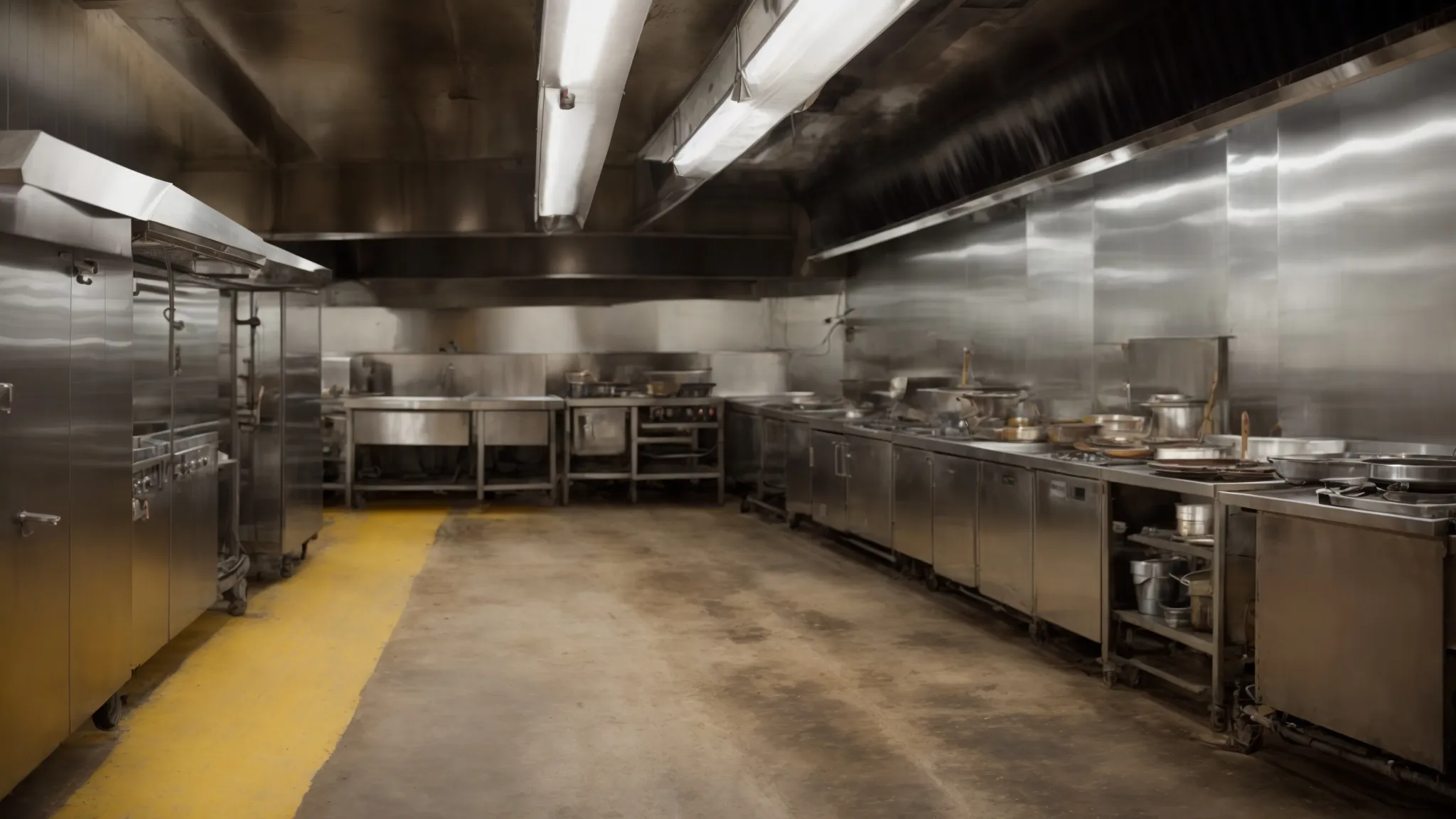
The cleanliness of a kitchen’s exhaust system is more than a mere aspect of routine maintenance; it is a critical component in ensuring safety and health within a commercial cooking environment.
Neglect in this area can lead to severe consequences, including heightened health hazards from airborne contaminants and an increased risk of fire outbreaks.
The accumulation of grease within extractor systems not only facilitates the growth of harmful bacteria but also acts as fuel for potentially devastating fires.
Recognizing and addressing these risks through regular cleaning and inspection is paramount for maintaining a safe, efficient, and health-compliant kitchen.
Health Hazards Posed by Greasy Extractor Systems
Neglected kitchen exhaust systems laden with grease pose serious health hazards by fostering an environment conducive to the growth of bacteria and mold. These contaminants can become airborne, compromising the air quality of the kitchen and, by extension, the entire restaurant.
The circulation of contaminated air not only puts the kitchen staff at risk but also the patrons who visit the establishment. Respiratory issues, allergic reactions, and other health problems can arise from prolonged exposure to these airborne contaminants:
- Respiratory issues due to the inhalation of contaminated air.
- Allergic reactions are triggered by mold spores and bacteria.
- Potential food contamination leads to foodborne illnesses.
Moreover, the accumulation of grease within the exhaust system increases the risk of fire, which presents an immediate danger to the health and safety of everyone in the vicinity. Ensuring regular cleaning and maintenance of kitchen exhaust systems is not just a regulatory requirement but a critical practice for safeguarding public health.
The Fire Risks Associated With Poorly Maintained Hoods
Poorly maintained kitchen hoods present a significant fire hazard, as they allow grease and particulate buildup to accumulate. This residue can ignite from a high-temperature flame or even a spark, turning a manageable situation into a catastrophic event in moments. Regular cleaning and maintenance of these systems are essential for preventing such dangers.
The role of kitchen hoods in ventilating smoke and heat away from cooking areas cannot be overstated, yet when neglected, they become one of the most vulnerable points in a commercial kitchen’s fire safety plan. A fire starting in a greasy, poorly maintained hood is challenging to control and can spread rapidly, endangering lives and causing substantial property damage.
Engaging professional services like Ontario Hood Cleaning to assess and clean kitchen exhaust systems is a proactive measure against fire risks. Their expertise not only ensures that hoods and exhaust systems are free from hazardous grease buildup but also enhances the overall safety and compliance of the kitchen environment with local fire codes.
Recognizing the hazards of ignored exhaust systems is just the beginning. Up next, discover how a detailed maintenance log can revolutionize your kitchen’s safety and performance.
Keeping a Maintenance Log for Accountability and Efficiency
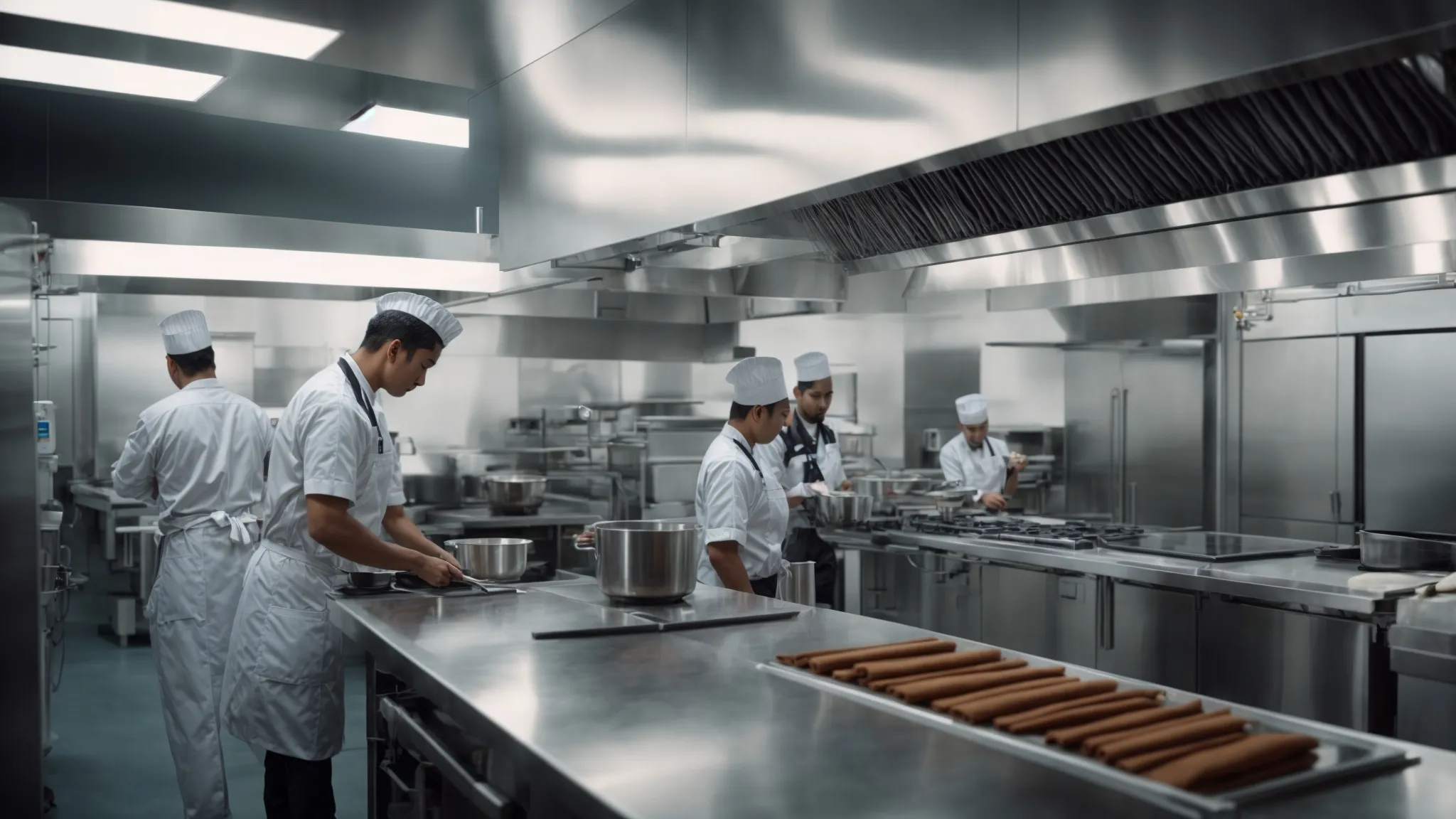
Maintaining a detailed log of kitchen exhaust maintenance activities plays a pivotal role in ensuring long-term system efficiency and adherence to safety standards. This practice allows restaurant owners and kitchen managers in Ontario and beyond to track the frequency and extent of cleanings, inspections, and any repairs made to the exhaust systems. Keeping such records promotes accountability within the maintenance team and ensures commitment to a cleanliness regimen.
By documenting each service conducted by professionals like Ontario Hood Cleaning, establishments create a transparent and reliable history of their exhaust system’s condition. This historical data becomes invaluable, offering insights into the system’s performance trends and helping identify recurrent issues that may require a more targeted intervention. It aids in planning future maintenance, ensuring that the kitchen exhaust remains in optimal working order.
Additionally, a meticulously updated maintenance log serves as proof of compliance with local health and fire safety regulations. This documentation can be critical during inspections, substantially easing the process of demonstrating adherence to mandated cleanliness standards. It shows a proactive effort to maintain a safe and healthy cooking environment, highlighting the establishment’s commitment to public safety.
Implementing the use of a digital log offers an even greater advantage, allowing for real-time updates and easy access to the maintenance history. This modern approach facilitates quick decision-making, enabling restaurant managers to respond efficiently to any signs of system degradation. It also simplifies the scheduling of professional cleaning services, ensuring that establishments remain within their routine maintenance cycles without fail.
Ultimately, the practice of keeping a comprehensive maintenance log reinforces an establishment’s dedication to maintaining a clean, safe, and efficient kitchen exhaust system. It not only contributes to the longevity of the equipment but also underscores a commitment to upholding health standards and enhancing the overall reputation of the restaurant or commercial kitchen. Engaging with service providers like Ontario Hood Cleaning, who understand the significance of detailed records, ensures a partnership aimed at safeguarding the efficiency and safety of kitchen operations.
Final Thoughts
Maintaining a clean kitchen exhaust system is non-negotiable for restaurant owners and commercial kitchens and is pivotal for ensuring operational efficiency, safety, and compliance with health standards.
Recognizing early signs of grease buildup, such as oily residues, unusual odors, and reduced airflow, is crucial to preventing potential hazards, including fire risks and health issues like respiratory problems and allergic reactions.
Regular professional inspections play a vital role in identifying and addressing these issues early on, with services like Ontario Hood Cleaning offering comprehensive cleanings that extend equipment lifespans and uphold air quality.
Additionally, engaging in daily cleaning practices, selecting quality grease filters, and ensuring their timely replacement significantly reduces the risk of grease accumulation, further safeguarding the kitchen environment.
A meticulous maintenance log enhances accountability and efficiency, showcasing a commitment to public safety and regulatory compliance.
Ultimately, a proactive approach to kitchen exhaust maintenance translates to a safer, more pleasant cooking environment, highlighting the importance of best practices in keeping kitchen exhausts clean.

